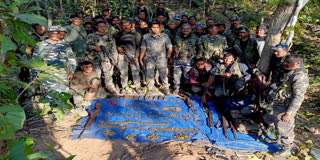
One such incident occurred at the Pusuguppa CRPF camp in Telangana's Maoist-infested region. Naxals utilized incense sticks to ignite firecrackers, creating an initial disturbance that prompted the security forces to focus on a potential breach. However, this distraction paved the way for the Maoists to launch more lethal attacks using improvised rockets and gunfire from concealed positions.
The skirmish, which took place late in the evening, saw a strategic combination of fireworks and incense sticks used to delay detection and facilitate the assault. According to sources familiar with the situation, the blasts were heard 200 meters away from the camp, diverting the troops’ attention. As the CRPF personnel mobilized to respond, they were met with heavy gunfire and rocket attacks. This confrontation lasted approximately 45 minutes before the insurgents retreated into the forest.
Security officials have expressed concern over this new tactic, which exploits the simplicity and accessibility of Diwali crackers and incense sticks to destabilize security forces. Although the CRPF managed to retaliate and prevent further damage during the Telangana incident, the fact that such rudimentary items could be weaponized underscores the resourcefulness of the Naxal groups.
This method has raised alarms within the anti-Naxal task forces, who believe the tactic could evolve. The attacks, though still sporadic, signify a growing trend of utilizing everyday items to disrupt the operations of security forces. The innovative use of household goods highlights the adaptability of the Naxals, who have been striving to outmaneuver the heavily armed forces in these conflict zones.
Experts monitoring Left-wing insurgency activities believe that the Maoists are resorting to these tactics in response to increased pressure from government forces. CRPF and other anti-Naxal operations have been intensifying in regions like Telangana, Chhattisgarh, and Odisha, pushing Maoists to seek alternative methods of launching attacks. This unconventional warfare is seen as an attempt to maintain the element of surprise and reduce the risk of direct confrontation with well-equipped forces.
Naxal insurgents have previously shown a tendency to adopt low-tech methods to achieve high-impact results, with examples ranging from the use of IEDs (improvised explosive devices) to ambush tactics in dense forest areas. The use of Diwali crackers, however, is seen as a significant shift in their strategy, representing a focus on psychological warfare by creating confusion and chaos in the minds of the troops.
The CRPF has confirmed that it is revisiting its standard operating procedures (SOPs) in light of these developments, to mitigate risks posed by these improvised tactics. Security analysts emphasize that insurgents may continue to refine their approach, increasing the complexity of attacks in the future. Therefore, officials believe that both vigilance and adaptation to these evolving methods are critical in maintaining security across Naxal-affected areas.
Authorities have also warned local populations, especially during festival seasons, to be vigilant regarding the misuse of materials that could be repurposed for insurgent activities. Security forces are considering stepped-up intelligence efforts and community engagement to better identify potential threats ahead of time.
